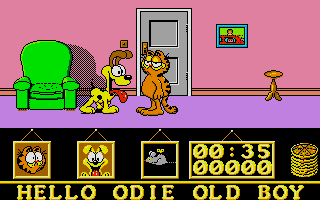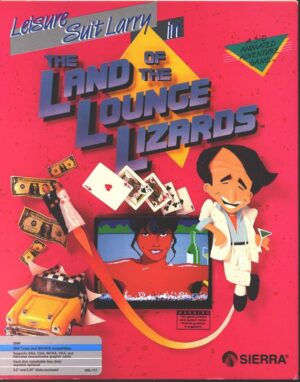Retro Replay Review
Gameplay
Garfield: Big, Fat, Hairy Deal centers on simple yet engaging puzzle mechanics that capture the spirit of Jim Davis’ famous cartoon cat. You guide Garfield through interconnected rooms and outdoor areas as he attempts to rescue his sweetheart Arlene from the local cat pound. The core loop revolves around object manipulation—picking up items, trading them with secondary characters, and using them to unlock new paths or earn vital resources.
Interactions with familiar faces like Odie and Nermal add both strategy and humor. Odie can be swiped for points, turning the loyal dog into a bit of a playful hazard, while Garfield’s pampered cousin Nermal offers assistance by carrying objects or activating switches. These supporting characters create light puzzle elements, forcing you to decide the optimal moment to trade carrots for crates or milk for keys.
Resource management is critical. Garfield must eat and rest regularly, or he’ll nod off mid-journey and trigger an instant Game Over. This simple hunger and fatigue meter provides a mild layer of tension as you scramble to find food at the butcher’s shop or a cozy bed for his afternoon nap. Contact with foes like rats, spiders, and a cantankerous butcher drags down Garfield’s energy, demanding careful navigation and occasional backtracking.
The overall pacing balances exploration with trial-and-error. Early rooms can feel a bit unforgiving—dropping an essential item might force you to retrace your steps—but perseverance uncovers new shortcuts and secret areas. For fans of classic 8-bit puzzle adventures, the mix of platforming obstacles and inventory-based challenges delivers a satisfying, bite-sized experience.
Graphics
On Commodore 64 and ZX Spectrum hardware, Garfield: Big, Fat, Hairy Deal makes the most of its limited 8-bit palette. The title screen proudly displays a chunky pixel-art Garfield, instantly recognizable with his trademark half-lidded expression. In-game sprites are colorful and well-animated, ensuring that each character—whether it’s an angry butcher, a bouncing Odie or a snooty Nermal—retains its cartoon charm.
Backgrounds feature simple, repeating tile sets that convey the atmosphere of a suburban neighborhood, the bustling butcher’s shop, and the grim walls of the cat pound. While certainly not as detailed as later 16-bit adventures, the environments have enough variety to keep the visual experience fresh across multiple levels. Minor graphical glitches and flicker can occur when too many sprites overlap, but these quirks are par for the course on hardware of this era.
Animation cycles are brief yet effective. Garfield’s walk cycle alternates between two frames of leg-shuffling, but his iconic smug grin is ever-present. Collecting an item triggers a brief sparkle effect, and trading objects prompts a small “exchange” animation that reinforces the puzzle logic. Despite the technical constraints, the game nails the aesthetic feel of the Garfield universe.
Sound design complements the visuals with boppy chiptune themes and minimal sound effects. A jaunty melody plays during exploration, while a descending tone warns of falling energy or approaching Game Over. Although these tunes loop quickly and can grow repetitive, they successfully replicate the playful mood of Garfield comics.
Story
The narrative premise is delightfully straightforward: Garfield’s beloved Arlene has been ensnared in the cat pound, and only our pudgy hero can break her out. There’s no grand villain behind the scenes—just the dogcatcher’s rigid rules, an overzealous butcher, and a network of animal friends who either help or hinder your progress. This no-nonsense plot lets the gameplay shine, avoiding unnecessary exposition.
Encounters with secondary characters provide lighthearted moments. Nermal’s self-centered advice often backfires, leading to humorous dialogue about missing lasagna ingredients. Odie’s oblivious tail-wagging can block narrow passages, forcing you to “swipe” him away—an example of pure Garfield-style slapstick. Even the butcher, who doling out pork chops, occasionally scolds the cat for raiding his meat stock.
Although the story doesn’t evolve through cutscenes or lengthy text dumps, it’s threaded together by clever item descriptions and brief speech bubbles. Every new area reveals a snippet of Garfield’s world: whimsical references to lasagna ovens, bizarre contraptions in the junkyard, and the occasional cameo from Jon Arbuckle. These touches create an affectionate tribute to the comic strip, even if the overall plot remains linear.
The conclusion is suitably triumphant—once you’ve assembled the final key and navigated the pound’s maze-like corridors, Garfield frees Arlene, and the two stroll off into a pixelated sunset. It’s a simple payoff, but it resonates thanks to the genuine warmth of the characters you’ve shepherded through the game’s small but memorable universe.
Overall Experience
Garfield: Big, Fat, Hairy Deal offers a charming slice of early licensed gaming, marrying the lazy-cat humor of Jim Davis’ comic strip with classic object-based puzzles. Its brain-teasing trades and light platforming challenges are easy to learn, but mastering the energy-management system and keeping Garfield fed adds a touch of urgency not often found in similar titles of its era.
While the 8-bit graphics and repetitive music may feel dated to modern players, they carry a nostalgic appeal for retro enthusiasts. The game thrives on character interactions, inventive item combos, and a gentle difficulty curve that seldom feels punishing—though hardcore gamers might find themselves backtracking more than once after losing a critical object.
Casual gamers and Garfield fans will appreciate the game’s faithful adaptation of the cartoon’s tone. It’s bite-sized, cheerful, and quirky, making it an excellent choice for short play sessions. Even today, it stands as a noteworthy example of how to translate a beloved comic character into an interactive adventure without losing the core personality that made him a household name.
In summary, Garfield: Big, Fat, Hairy Deal may not reinvent the wheel, but it delivers a delightful package of puzzles, humor, and classic 8-bit charm. If you’re eager for a retro romp through Garfield’s world, complete with energy management and occasional canine interference, this nostalgic title remains a worthwhile excursion into the golden age of licensed video games.
 Retro Replay Retro Replay gaming reviews, news, emulation, geek stuff and more!
Retro Replay Retro Replay gaming reviews, news, emulation, geek stuff and more!









Reviews
There are no reviews yet.